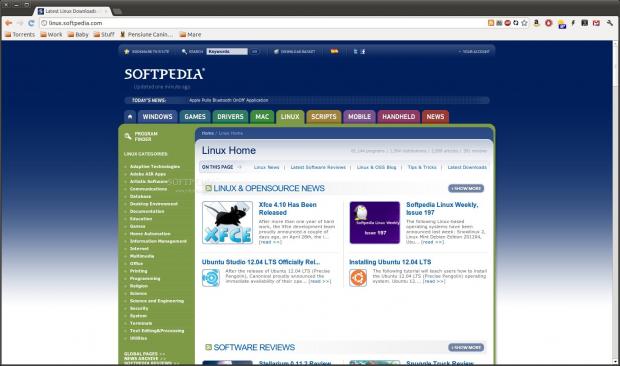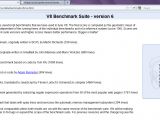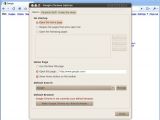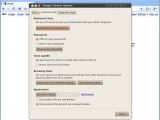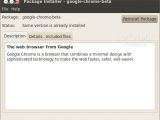There's hardly a piece of software more important for a desktop operating system these days than the web browser. Even the most casual of users will end up employing one several times per day. You could argue that Linux has always had a wide variety of browsers to choose from and, if you just look at the numbers you're definitely right. But, with the risk of getting a lot of people aggravated, I'll say that there has been only one real option for Linux users and that is Mozilla Firefox. Everything else, from Konqueror to Opera, just doesn't stack up and not for lack of trying.
So how would a newcomer to Linux and to web browsers in general, like Google, manage? Remarkably well, it turns out. Jumping ahead a bit, Google Chrome probably won't replace Firefox for most people and it's not going to become the default web browser in a mainstream Linux distro anytime soon, but it does so many things different and/or better than anyone else that there's no doubt Chrome is going to find a lot of fans in the Linux crowd.
Installation and first load
First things first, in order to try it out you're going to need to get a hold of it. You can grab Google Chrome from the download link above, or go to the official Google page, and the entire process is pretty straightforward. You can download the Google Chrome dev channel build (currently Google Chrome 5.0.342.3) if you're feeling a bit adventurous and positively need to be on the cutting edge but for this review we'll be sticking to the relatively stable Google Chrome 5.0.307.11 Beta.
Beta builds have been coming out for about three months now for Linux but a stable release hasn't been made available yet. It should be coming in the next few months but for most purposes the Google Chrome 5 Beta is solid enough to be run on a production machine. We'll be testing Google Chrome 5 Beta on the latest Ubuntu 10.04 Alpha 3 with all the up-to-date packages and the delicious, new Ubuntu theme, but the underlying distribution doesn't really matter that much. After getting a hold of the .deb package you can either open it directly from your browser's downloads window or save it and open it from your computer. The GDebi package installer should spring into action and with just a couple of clicks Google Chrome is ready to be put through its paces.
A very nice touch is that the installer also adds the Google Chrome repositories to your 'sources.list' file so the browser will get automatically updated every time a new build is out (which will be very soon at the pace at which Google developers are working). Now that everything is set, it's time to take this thing for a spin. If you've never used Google Chrome, get ready to be more than a bit surprised and maybe a little lost, you haven't seen anything like this before. A bright blue window welcomes you at first and, though everything is recognizable, it certainly doesn't look like your standard cookie-cutter Linux application.
The look
There is no title bar, in the traditional sense, there is no menu bar, there isn't even a status bar. Everything has been stripped to the bare minimum, not surprising, knowing that this thing comes from Google. There is a small number of buttons in the main toolbar, back, forward, reload and home, the last of which can be removed from the options menu if you feel it clutters up the interface. Then comes one of Google Chrome's most interesting features, the Omnibox, designed to be part address box, part search box. Finally there are a couple of menu buttons that house the other common tools you'd expect to find in a web browser. The browser tabs are integrated with the title bar in Google Chrome and the status bar only pops up when it is needed.
It may take a bit of getting used to at first but after a while you realize that less is better when it comes to good software UI design. After all, what you're interested in is the actual content and the browser should do as little as possible to get in the way of that. And if you're not convinced that this is the way to go maybe the fact that both Opera and Firefox are now 'borrowing' some of Google Chrome's best UI elements should be proof enough. Opera 10.50, which isn't available yet on Linux, does away with the antiquated menu bar and the upcoming Firefox 4.0 will take a very similar approach.
The feel
The first thing you notice about Google Chrome, after you manage to get past the initial visual 'shock,' is the speed. It's a subjective measure for sure, without doing any actual benchmarking, but the speed with which Google Chrome loads is hard not to notice. Frankly, this is how all software on a modern computer should behave, you click the icon and the window should load up before you've even had time to move away the mouse. The swiftness of Google Chrome is apparent after the first load too, moving from one tab to the other is very fast as is everything having to do with the interface. Everything having to do with the UI is fast and intuitive and there's little to impute Google for here.
Rendering (HTML and JavaScript)
The speed translates to how Google Chrome renders the actual web pages as well. Google Chrome uses the Webkit rendering engine, developed by Apple for Safari and based intially on the KHTML open-source libraries. Apple managed to create quite a powerful engine and thanks to the open-source nature of the project it has been adopted and integrated by plenty of web browsers out there, especially on the mobile front.
Google went with the 'if it ain't broke don't fix it' philosophy and rather than coming up with its own rendering engine, which would have meant a lot of time and resources spent, took Webkit and built on top of it. So, in this respect, Google Chrome comes with one of the best web page rendering engines out there, if not the best certainly the most popular.
One of the main bragging points of Google Chrome when it first launched and to this day has been the underlying V8 JavaScript engine. It was the fastest JavaScript engine in the world when it came out, blowing away the competition, and, even though things are much closer these days, it is still a very capable beast having only recently been overtaken by the latest Opera 10.50 in benchmarks.
As for rendering accuracy, Google Chrome also performs rather well. Google is a strong believer in open web standards and the fact that it is using Webkit only helps. HTLM5 support is on par with everything else out there and there's nothing to criticize in this area. It's the same story with JavaScript, Google Chrome came in third in Google's own compliance tests.
Main Features
The Omnibox. Google Chromes' most defining feature, the address box - search box hybrid, is one of its strong points but also one of its weaknesses. It may take a little to get used to it but after a while you begin to wonder why everyone else hasn't done this before and why in the world would you have two features doing pretty much the same thing and taking up precious space in the process.
After all, people rarely know exactly where they want to go and most of the time they start off with a search. With the Omnibox, they get redirected to their preferred search engine for every query they type. However, the tool also serves as a suggestion box, like Firefox's Awesome bar, which integrates history and bookmark search, but taking things further by integrating web search as well in the suggestions.
Still, at times it can be a bit annoying. For example, typing 'reader' in the Firefox Awesome bar will load Google Reader for me. Doing the same in Google Chrome will lead me to a search page for the word 'reader' where Google Reader will be the first result. This may not sound like too much of a hassle but it still adds a couple of, unnecessary, steps to the process. You could argue that this doesn't have to happen as typing in Chrome will obviously suggest Google Reader so, in the end, it would take just one additional click to get there but it means moving your hand from the keyboard to the mouse and, frankly, it's one click I'd rather not have to make.
Bookmarks and History. These tools work pretty much like in any other browser and there's nothing spectacular or very wrong with them in Google Chrome. History loads in a full new tab and you can see the timeline and search through with the integrated search feature.
There is a dedicated Bookmark Manager, which opens up in a new page, but it's standard nuts-and-bolts stuff, nothing too exciting. However, the bookmarks toolbar, or rather the way Google Chrome handles the feature, is exciting or at least interesting. By default the bookmarks toolbar isn't visible to save up space in the minimalistic UI. However, you can press Ctlr+B to activate it if you need quick access to a page and then press the same keyboard shortcut to tuck it away until you need it again. The bookmarks toolbar is also available when opening up a new tab. The New Tab Page. The feature is one of the more useful of Google Chrome though it's not exactly original. The concept was pioneered by Opera but with Chrome Google took things one step forward. There is a thumbnail view of the most visited web sites, but this can double as a Speed Dial-style feature as pages can be pinned to the section. It also features the aforementioned Bookmark Toolbar and lists the most recently visited web sites.
Customization and integration
One of the main draws of Linux and Linux software is the endless customization possibilities. Linux users want things to look and feel exactly as they like them and take pride in getting everything working to their satisfaction. Luckily Google Chrome comes with some compelling options in this department as well though it probably won't satisfy the most demanding of users.
For those wanting a uniform look across all of their apps, Google Chrome also comes with a native GTK-based interface, available in the Options dialog under the Personal Stuff tab. Choose this option and Chrome will use the default icons and colors from the system-wide GTK theme selected. However, the browser's (few) interface elements will still retain their default look. You can take things even further by enabling the "Use system title bar and borders" options.
On the other hand, if you're bored with the stale looks of either the default theme or the GTK-based one you can check out the online theme gallery Google has provided. There are plenty of themes to choose from, both from Google and from various artists, but, truth be told, most of them are on the ugly and/or cheesy side. If bright colors and flashy graphics are your thing then there's certainly something in there for you. Most people will end up going back to the default themes though.
Extensions
Idealists may want to believe that it's the open-source nature of the project and the great community that helped Mozilla Firefox become the most popular alternative web browser in the world and spark a veritable browser revolution. But the fact is, most people are a lot more concerned about the practical side of things and likely the single biggest thing that pushed Firefox adoption is its add-on platform. Thousands of developers have created extensions for Firefox that satisfy even the most obscure needs and niches. In fact, it's the one thing that would keep most people from switching browsers, for fear of losing all of their precious add-ons.
Luckily, Google Chrome also has its own extensions gallery, even if only since a few months ago, and there are almost 3,500 extensions in there at the time of writing. It's nowhere near the number of add-ons available for Firefox but it's growing steadily. All the most popular add-ons have been ported to Google Chrome or have alternatives and the extensions platform has a few clear avantages over Firefox's, the biggest of which is not having to restart the browser every time you install a new one. In fact, Mozilla is now working on a very similar add-on platform with Jetpack. You can check out some Google Chrome extensions here.
Usability and stability
Google Chrome, for all its innovations, is just a browser. It does a few things differently and some might find that, once they get used to it, it helps them get the job done faster or easier than Firefox or other browsers but don't expect anything revolutionary.
Don't be fooled by the beta label, Google Chrome is more than suited for serious work. Google has a knack for keeping products in beta for extended periods of time, Gmail was in beta for five years, so the concept means something a bit different for Google developers than for the rest of the world. That being said, it's still not on par with Firefox and there are a couple of glitches and annoying minor flaws. They're far from a deal breaker but after you've spent enough time using Google Chrome it's hard not to notice them.
Google Chrome and open source
This issue is a bit tricky. Google Chrome is not, in fact, open source by itself. It's free and available to anyone but it comes with a pretty clear license agreement, well, as clear as license agreements can get anyway, that specifically forbids people from trying to reverse-engineer the code in order to copy, modify or distribute it.
However, it is very closely based on the Chromium open-source project, where the active development for Google Chrome is being done. For all intents and purposes, Chromium is Google Chrome without the branding and with more experimental code. Any Free GNU/Linux distribution that would want to bundle Chrome would choose Chromium but there's little reason besides 'principles' to do so for the average user. Conclusion
Google Chrome is one of those things that you either love or hate. In fact, it will probably be a mixture of the two but one thing's for sure: there's little about it that you'd call boring or ignorable. There's plenty to like about Google Chrome and it gets a lot of things right, which is why plenty of other browser makers are taking more than a few cues from Google's browser. Chrome has been out for a year and a half on Windows and more than half a year on Linux. Google has been pushing betas for Linux since December but even so, at this point, Chrome has a well-rounded set of features and stability isn't an issue.
However, if you're looking for a Firefox replacement, Google Chrome isn't it. For one thing, there are still some features missing. It's nothing crucial but some of the omissions are by choice so they're not going to change anytime soon. Secondly, it does quite a few things differently from Firefox, some for the better, some for the worse, but in most cases it's up to the individual user to judge. But this, in fact, it's how it should be. Google Chrome shouldn't be just another Firefox, even a better one. Real choice is when people can have a great browser that caters to their own needs rather than trying to satisfy everyone and that's the one thing that Google Chrome does provide, a real choice, a viable web-browser alternative to the established ones.
 14 DAY TRIAL //
14 DAY TRIAL // 
